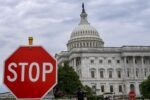On October 2, 2025, French unions continued their national strike demanding “social justice” as Prime Minister Sébastien Lecornu prepares to present a budget plan aimed at reducing France’s high debt.
Protest Scale and Participation
Around 300,000–350,000 people participated nationwide, down about 30% from the opening day two weeks ago, which drew over 500,000 protesters. In Paris, up to 40,000 demonstrators marched from Place d’Italie to Place Vauban, near the National Assembly, with roughly 5,000 police deployed to maintain order. Across France, about 76,000 officers were mobilized.
Impact on Public Services
- Airports: Striking airport workers may cause flight delays.
- Education: About 27% of school staff, including teachers and psychologists, joined the strike. Students also staged protests and blocked schools in Paris, Bordeaux, and Montpellier.
- Tourism: The Eiffel Tower closed to the public due to the strike, the second closure in one month.
Political and Financial Context
France’s budget deficit reached 5.8% of GDP last year, nearly double the EU limit of 3%. The political class remains divided on how to reduce it. Former Prime Minister François Bayrou resigned on September 8 after proposing €44 billion in cuts.
New Prime Minister Sébastien Lecornu must secure parliamentary approval for the 2026 budget while unions demand:
- Increased funding for public services
- Higher taxes on the wealthy
- Reversal of pension reforms
The Prime Minister’s office is considering fiscal measures such as tax breaks for low-income families, exemptions on overtime pay, and reinstating a tax-free “Macron bonus”, along with other financial relief options.







